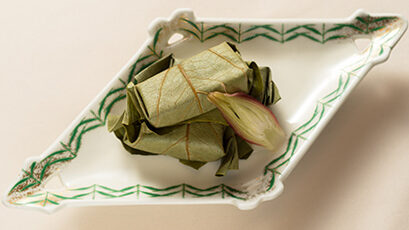
Imagine a bite-sized piece of tradition from the heart of Nara Prefecture. That’s “Kakinoha Zushi” – pressed sushi made with salt-cured mackerel and vinegared rice, all snugly wrapped in a fragrant persimmon leaf. This isn’t just about taste; the experience includes the subtle aroma transferred from the leaf to the sushi. It’s meant to be savored as is, appreciating the delicate interplay of flavors. If you happen to store it in the fridge and the rice gets a tad firm, a quick warm-up in the microwave will do the trick.After removing the leaf, enjoy it without adding soy sauce or any other condiments.
Dish Name: Kakinoha Zushi
- Region / Location: Nara Prefecture
- Primary Area of Tradition: Gojo City, Yoshino region
- Main Ingredients: Rice, mackerel (saba), persimmon leaves (kaki no ha)
How It’s Eaten / Served
Kakinoha Zushi is best enjoyed as it is, appreciating how the persimmon leaf subtly perfumes the sushi rice. The leaf is part of the experience! If you’ve kept it chilled and the rice has hardened a bit, a gentle warm-up in the microwave can bring it back to its delicious best. For a special treat in the colder months, try “Aburi Kakinoha Zushi.” Simply place the leaf-wrapped sushi in a toaster oven for about 3 to 4 minutes, heating it until the leaf’s surface is lightly toasted. This method releases an even richer aroma. Just keep a close eye on it to prevent burning!
Cultural Background and Preservation
In the Gojo and Yoshino regions, Kakinoha Zushi is a cherished part of summer festival feasts. In farming communities, it’s often made after the busy rice planting season, with even children helping in the preparation. Mackerel has long been an important celebratory fish, making Kakinoha Zushi a staple at festive occasions. The tannins in the persimmon leaves, combined with the vinegar in the rice, act as natural preservatives. This allows the flavors to mature and deepen overnight, resulting in its distinctive taste. Interestingly, in the mountainous areas, a similar type of sushi called “Hoba Zushi” is made from around the Boy’s Day festival through July, using fragrant magnolia leaves instead of persimmon leaves. Today, Kakinoha Zushi continues to be made for local events and is also served in restaurants. As a prominent Nara souvenir, it’s widely available at department store events across the country and as a popular ekiben (train station bento), making this flavorful tradition accessible to many.
Additional information:
- Pressed sushi (押し寿司 – oshizushi): A type of sushi made by pressing layers of rice and fillings into a mold. Kakinoha Zushi is a form of pressed sushi where the persimmon leaf acts as both the wrapper and part of the molding process.
- Umami (うま味): Often described as the fifth basic taste (after sweet, sour, salty, and bitter), umami is a savory taste that is often associated with brothy or meaty flavors. It comes from amino acids like glutamate, which are naturally present in many foods, including fish.
- Tannins: Natural compounds found in many plants, including persimmon leaves. They have a slightly bitter or astringent taste and can act as preservatives.
- Ekiben (駅弁): Japanese for “station bento,” a boxed meal commonly sold at train stations. They often feature local specialties.
The information about regional cuisine featured on this website (Piggy's Grandma of Japan) is summarized and adapted from the Ministry of Agriculture, Forestry and Fisheries of Japan (MAFF) website, "Our Regional Cuisines"Additional commentary is provided based on the unique experiences and perspectives of the site's editors.
The copyright for the original content regarding regional cuisine belongs to the Ministry of Agriculture, Forestry and Fisheries of Japan.
The summaries and adaptations published on this site are intended for informational purposes only. Piggy's Grandma of Japan does not guarantee the accuracy or completeness of this information. For the most accurate and complete details, please refer to the original pages on the MAFF website.

